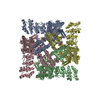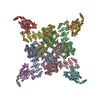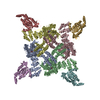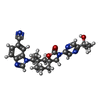[English] 日本語
 Yorodumi
Yorodumi- PDB-8fc7: Cryo-EM structure of the human TRPV4 - RhoA in complex with GSK2798745 -
+ Open data
Open data
- Basic information
Basic information
| Entry | Database: PDB / ID: 8fc7 | ||||||
|---|---|---|---|---|---|---|---|
| Title | Cryo-EM structure of the human TRPV4 - RhoA in complex with GSK2798745 | ||||||
 Components Components |
| ||||||
 Keywords Keywords | MEMBRANE PROTEIN/Hydrolase / TRPV4 / RhoA / GSK2798745 / MEMBRANE PROTEIN / MEMBRANE PROTEIN-Hydrolase complex | ||||||
| Function / homology |  Function and homology information Function and homology informationstretch-activated, monoatomic cation-selective, calcium channel activity / blood vessel endothelial cell delamination / regulation of response to osmotic stress / osmosensor activity / vasopressin secretion / positive regulation of striated muscle contraction / calcium ion import into cytosol / negative regulation of brown fat cell differentiation / positive regulation of microtubule depolymerization / positive regulation of macrophage inflammatory protein 1 alpha production ...stretch-activated, monoatomic cation-selective, calcium channel activity / blood vessel endothelial cell delamination / regulation of response to osmotic stress / osmosensor activity / vasopressin secretion / positive regulation of striated muscle contraction / calcium ion import into cytosol / negative regulation of brown fat cell differentiation / positive regulation of microtubule depolymerization / positive regulation of macrophage inflammatory protein 1 alpha production / hyperosmotic salinity response / positive regulation of chemokine (C-X-C motif) ligand 1 production / positive regulation of chemokine (C-C motif) ligand 5 production / cartilage development involved in endochondral bone morphogenesis / alpha-beta T cell lineage commitment / aortic valve formation / mitotic cleavage furrow formation / positive regulation of lipase activity / bone trabecula morphogenesis / endothelial tube lumen extension / skeletal muscle satellite cell migration / positive regulation of vascular associated smooth muscle contraction / angiotensin-mediated vasoconstriction involved in regulation of systemic arterial blood pressure / SLIT2:ROBO1 increases RHOA activity / RHO GTPases Activate Rhotekin and Rhophilins / Roundabout signaling pathway / negative regulation of intracellular steroid hormone receptor signaling pathway / Axonal growth inhibition (RHOA activation) / Axonal growth stimulation / cellular hypotonic salinity response / cleavage furrow formation / cellular hypotonic response / regulation of neural precursor cell proliferation / cortical microtubule organization / regulation of modification of postsynaptic actin cytoskeleton / regulation of osteoblast proliferation / forebrain radial glial cell differentiation / multicellular organismal-level water homeostasis / regulation of modification of postsynaptic structure / cell junction assembly / apical junction assembly / negative regulation of cell migration involved in sprouting angiogenesis / cellular response to chemokine / establishment of epithelial cell apical/basal polarity / positive regulation of vascular permeability / beta selection / osmosensory signaling pathway / regulation of systemic arterial blood pressure by endothelin / negative regulation of oxidative phosphorylation / negative regulation of motor neuron apoptotic process / RHO GTPases activate CIT / RHO GTPases Activate ROCKs / negative regulation of cell size / cell-cell junction assembly / positive regulation of monocyte chemotactic protein-1 production / PCP/CE pathway / Sema4D induced cell migration and growth-cone collapse / RHO GTPases activate KTN1 / calcium ion import / cell volume homeostasis / cellular response to osmotic stress / positive regulation of podosome assembly / positive regulation of alpha-beta T cell differentiation / Sema4D mediated inhibition of cell attachment and migration / apolipoprotein A-I-mediated signaling pathway / wound healing, spreading of cells / positive regulation of leukocyte adhesion to vascular endothelial cell / PI3K/AKT activation / odontogenesis / Wnt signaling pathway, planar cell polarity pathway / motor neuron apoptotic process / ossification involved in bone maturation / regulation of focal adhesion assembly / regulation of aerobic respiration / negative chemotaxis / TRP channels / EPHA-mediated growth cone collapse / apical junction complex / cortical actin cytoskeleton / stress fiber assembly / androgen receptor signaling pathway / diet induced thermogenesis / positive regulation of macrophage chemotaxis / myosin binding / positive regulation of cytokinesis / RHOC GTPase cycle / regulation of neuron projection development / cellular response to cytokine stimulus / cerebral cortex cell migration / ERBB2 Regulates Cell Motility / microtubule polymerization / semaphorin-plexin signaling pathway / calcium ion import across plasma membrane / cleavage furrow / ficolin-1-rich granule membrane / positive regulation of protein serine/threonine kinase activity / negative regulation of cell-substrate adhesion / RHOA GTPase cycle / mitotic spindle assembly / alpha-tubulin binding Similarity search - Function | ||||||
| Biological species |  Homo sapiens (human) Homo sapiens (human) | ||||||
| Method | ELECTRON MICROSCOPY / single particle reconstruction / cryo EM / Resolution: 3.3 Å | ||||||
 Authors Authors | Kwon, D.H. / Lee, S.-Y. / Zhang, F. | ||||||
| Funding support |  United States, 1items United States, 1items
| ||||||
 Citation Citation |  Journal: Nat Commun / Year: 2023 Journal: Nat Commun / Year: 2023Title: TRPV4-Rho GTPase complex structures reveal mechanisms of gating and disease. Authors: Do Hoon Kwon / Feng Zhang / Brett A McCray / Shasha Feng / Meha Kumar / Jeremy M Sullivan / Wonpil Im / Charlotte J Sumner / Seok-Yong Lee /  Abstract: Crosstalk between ion channels and small GTPases is critical during homeostasis and disease, but little is known about the structural underpinnings of these interactions. TRPV4 is a polymodal, ...Crosstalk between ion channels and small GTPases is critical during homeostasis and disease, but little is known about the structural underpinnings of these interactions. TRPV4 is a polymodal, calcium-permeable cation channel that has emerged as a potential therapeutic target in multiple conditions. Gain-of-function mutations also cause hereditary neuromuscular disease. Here, we present cryo-EM structures of human TRPV4 in complex with RhoA in the ligand-free, antagonist-bound closed, and agonist-bound open states. These structures reveal the mechanism of ligand-dependent TRPV4 gating. Channel activation is associated with rigid-body rotation of the intracellular ankyrin repeat domain, but state-dependent interaction with membrane-anchored RhoA constrains this movement. Notably, many residues at the TRPV4-RhoA interface are mutated in disease and perturbing this interface by introducing mutations into either TRPV4 or RhoA increases TRPV4 channel activity. Together, these results suggest that RhoA serves as an auxiliary subunit for TRPV4, regulating TRPV4-mediated calcium homeostasis and disruption of TRPV4-RhoA interactions can lead to TRPV4-related neuromuscular disease. These insights will help facilitate TRPV4 therapeutics development. | ||||||
| History |
|
- Structure visualization
Structure visualization
| Structure viewer | Molecule:  Molmil Molmil Jmol/JSmol Jmol/JSmol |
|---|
- Downloads & links
Downloads & links
- Download
Download
| PDBx/mmCIF format |  8fc7.cif.gz 8fc7.cif.gz | 1.1 MB | Display |  PDBx/mmCIF format PDBx/mmCIF format |
|---|---|---|---|---|
| PDB format |  pdb8fc7.ent.gz pdb8fc7.ent.gz | 915.1 KB | Display |  PDB format PDB format |
| PDBx/mmJSON format |  8fc7.json.gz 8fc7.json.gz | Tree view |  PDBx/mmJSON format PDBx/mmJSON format | |
| Others |  Other downloads Other downloads |
-Validation report
| Summary document |  8fc7_validation.pdf.gz 8fc7_validation.pdf.gz | 1.7 MB | Display |  wwPDB validaton report wwPDB validaton report |
|---|---|---|---|---|
| Full document |  8fc7_full_validation.pdf.gz 8fc7_full_validation.pdf.gz | 1.7 MB | Display | |
| Data in XML |  8fc7_validation.xml.gz 8fc7_validation.xml.gz | 90.8 KB | Display | |
| Data in CIF |  8fc7_validation.cif.gz 8fc7_validation.cif.gz | 132.7 KB | Display | |
| Arichive directory |  https://data.pdbj.org/pub/pdb/validation_reports/fc/8fc7 https://data.pdbj.org/pub/pdb/validation_reports/fc/8fc7 ftp://data.pdbj.org/pub/pdb/validation_reports/fc/8fc7 ftp://data.pdbj.org/pub/pdb/validation_reports/fc/8fc7 | HTTPS FTP |
-Related structure data
| Related structure data |  28975MC  8fc8C  8fc9C  8fcaC  8fcbC M: map data used to model this data C: citing same article ( |
|---|---|
| Similar structure data | Similarity search - Function & homology  F&H Search F&H Search |
- Links
Links
- Assembly
Assembly
| Deposited unit | 
|
|---|---|
| 1 |
|
- Components
Components
| #1: Protein | Mass: 102057.797 Da / Num. of mol.: 4 Source method: isolated from a genetically manipulated source Source: (gene. exp.)  Homo sapiens (human) / Gene: TRPV4, VRL2, VROAC / Production host: Homo sapiens (human) / Gene: TRPV4, VRL2, VROAC / Production host:  Homo sapiens (human) / References: UniProt: Q9HBA0 Homo sapiens (human) / References: UniProt: Q9HBA0#2: Protein | Mass: 21799.158 Da / Num. of mol.: 4 Source method: isolated from a genetically manipulated source Source: (gene. exp.)  Homo sapiens (human) / Gene: RHOA, ARH12, ARHA, RHO12 / Production host: Homo sapiens (human) / Gene: RHOA, ARH12, ARHA, RHO12 / Production host:  Homo sapiens (human) / References: UniProt: P61586, small monomeric GTPase Homo sapiens (human) / References: UniProt: P61586, small monomeric GTPase#3: Chemical | ChemComp-XPW / #4: Chemical | ChemComp-MG / #5: Chemical | ChemComp-GDP / Has ligand of interest | Y | |
|---|
-Experimental details
-Experiment
| Experiment | Method: ELECTRON MICROSCOPY |
|---|---|
| EM experiment | Aggregation state: CELL / 3D reconstruction method: single particle reconstruction |
- Sample preparation
Sample preparation
| Component | Name: The complex of human TRPV4 with RhoA / Type: COMPLEX / Entity ID: #1-#2 / Source: RECOMBINANT |
|---|---|
| Molecular weight | Value: 0.45 MDa / Experimental value: YES |
| Source (natural) | Organism:  Homo sapiens (human) Homo sapiens (human) |
| Source (recombinant) | Organism:  Homo sapiens (human) Homo sapiens (human) |
| Buffer solution | pH: 8 |
| Specimen | Embedding applied: NO / Shadowing applied: NO / Staining applied: NO / Vitrification applied: YES |
| Specimen support | Grid material: GOLD / Grid type: UltrAuFoil R1.2/1.3 |
| Vitrification | Instrument: LEICA EM GP / Cryogen name: ETHANE / Humidity: 95 % / Chamber temperature: 281.15 K |
- Electron microscopy imaging
Electron microscopy imaging
| Microscopy | Model: FEI TITAN |
|---|---|
| Electron gun | Electron source:  FIELD EMISSION GUN / Accelerating voltage: 300 kV / Illumination mode: OTHER FIELD EMISSION GUN / Accelerating voltage: 300 kV / Illumination mode: OTHER |
| Electron lens | Mode: BRIGHT FIELD / Nominal magnification: 81000 X / Nominal defocus max: 3000 nm / Nominal defocus min: 800 nm |
| Image recording | Electron dose: 60 e/Å2 / Film or detector model: GATAN K3 BIOQUANTUM (6k x 4k) |
- Processing
Processing
| CTF correction | Type: PHASE FLIPPING AND AMPLITUDE CORRECTION |
|---|---|
| Symmetry | Point symmetry: C4 (4 fold cyclic) |
| 3D reconstruction | Resolution: 3.3 Å / Resolution method: FSC 0.143 CUT-OFF / Num. of particles: 119462 / Symmetry type: POINT |
 Movie
Movie Controller
Controller









 PDBj
PDBj




















